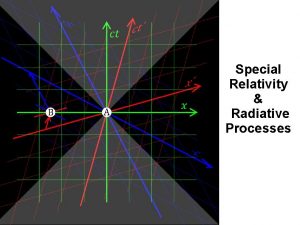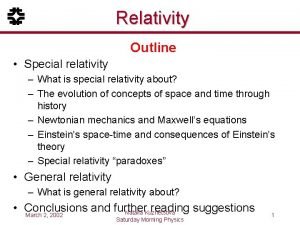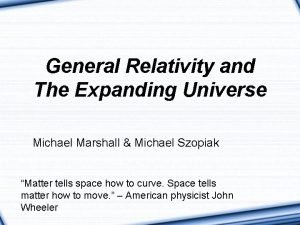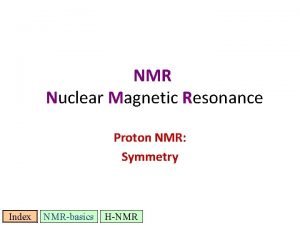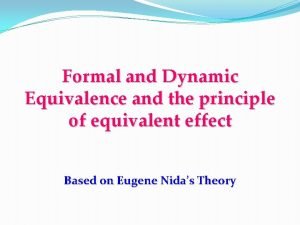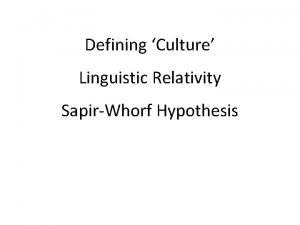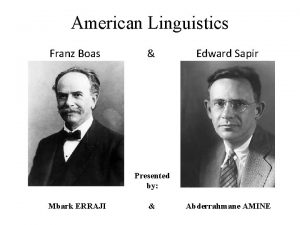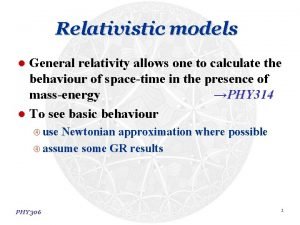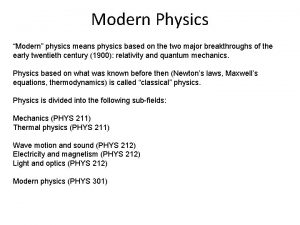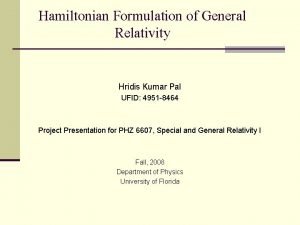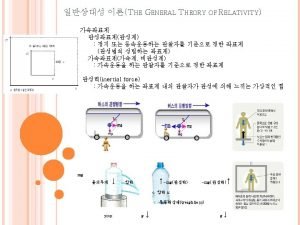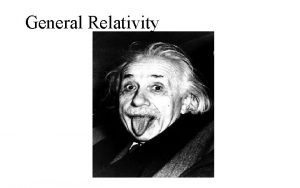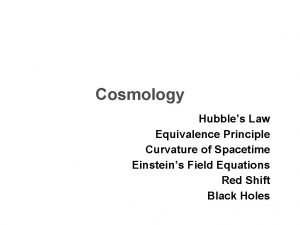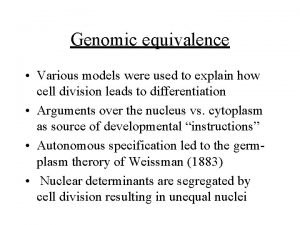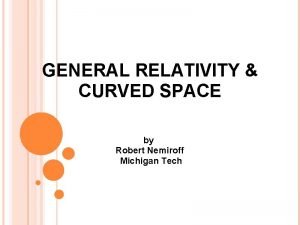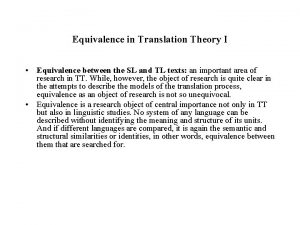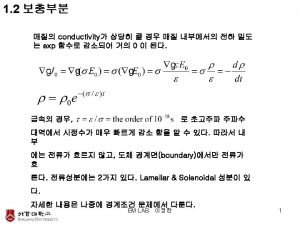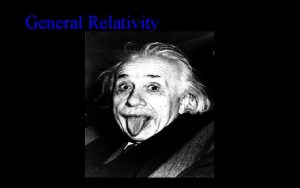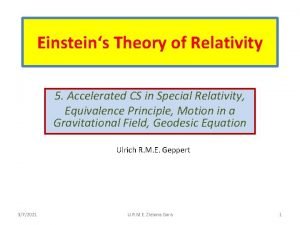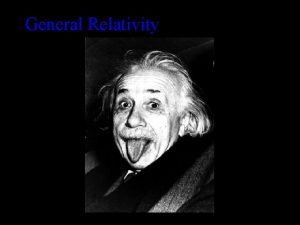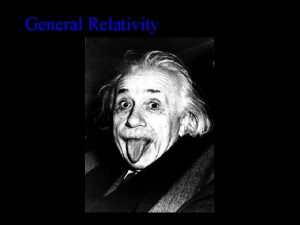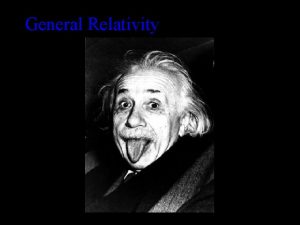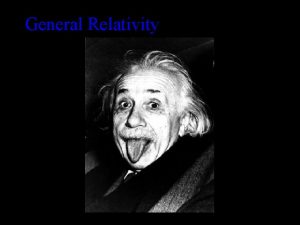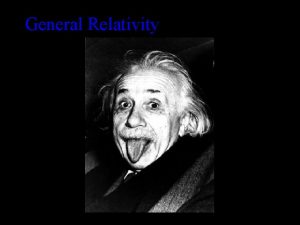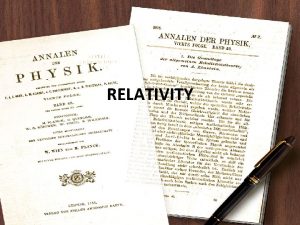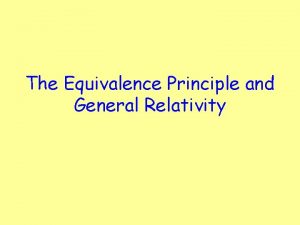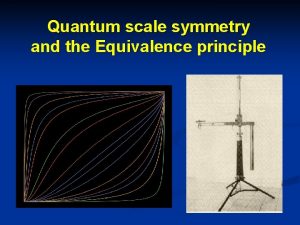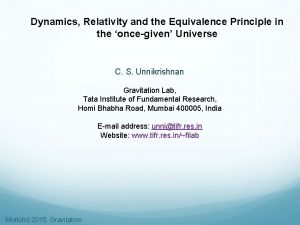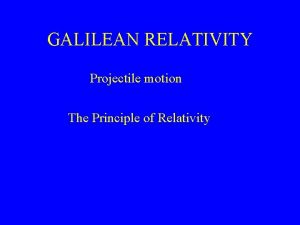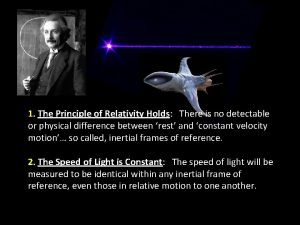General Relativity General Relativity Principle of equivalence There


























- Slides: 26

General Relativity

General Relativity Principle of equivalence: There is no experiment that will discern the difference between the effect of gravity and the effect of acceleration. Or… Gravitational and inertial mass are equivalent.

Principle of equivalence: On Earth: In space: a = 9. 8 m/s/s

Principle of equivalence: You feel Zero “g”s in free fall

Apparent Curvature of light: Not accelerating Accelerating up so fast the lady’s a goner

Apparent Curvature of light: In 1919, Sir Arthur Eddington measured the deflection of light near the sun during an eclipse. Light was bent twice as much as Newton’s theory predicted, supporting General Relativity

Gravitational Lensing:

Gravitational Lensing:

Curvature of Space: Now that you understand that gravity bends light… Understand that it does not. Light travels in a straight line. The space itself near a massive object is curved. Light is the absolute. It travels at the speed of light. It travels in a straight line. Do not adjust your television set… Re-adjust your brain.

Curvature of Space: Mass distorts space

Curvature of Space: Geometry is Non-Euclidian Were the sphere large enough…

Black Holes: Light cannot escape…

Black Holes: Gravitational Potential per unit mass: V = -GM r so PE = Vm At escape velocity, kinetic = potential 1/ 2 = GMm substituting c for v: mv 2 r r = 2 GM where r is the Schwarzschild radius c 2

Black Holes: At escape velocity, kinetic = potential 1/ 2 = GMm substituting c for v: mv 2 r v = (2 GM/r)1/2 As r gets smaller, v gets bigger Were the Earth. 35” in radius it would be a black hole The sun would be 1. 9 miles in radius. The sun and the earth will never become black holes. Not all by themselves…

What is the maximum radius of a black hole that is 1. 44 times the mass of the sun? Msun = 1. 99 x 1030 kg r = 2*6. 67 E-11*1. 44*1. 99 E 30/3 E 82 = 4247. 456 m = 4250 m

What is the mass of a black hole the size of the earth? 6 r = 6. 38 x 10 m M = rc 2/(2 G) = 6. 38 E 6*3 E 82/(2*6. 67 E-11) = 4. 3 E 33 kg

Clocks and gravitation: General relativity predicts that clock A will run faster than clock B… From Feynman Lectures in Physics

Clocks and gravitation: • Ship accelerating up • Observer at bottom of ship • Clocks emit pulses of light • Pulse 1 goes distance L 1 • Pulse 2 goes distance L 2 • L 2 is shorter than L 1 • Observer sees ticks closer together in time. • If it always appears to be running faster, it is… • Principle of equivalence says gravity must also cause this. From Feynman Lectures in Physics

Clocks and gravitation: • Principle of equivalence says gravity must also cause this. This -> From Feynman Lectures in Physics

Clocks and gravitation: • Principle of equivalence says gravity must also cause this. g = 9. 8 m/s/s Is the same as This -> From Feynman Lectures in Physics

Clocks and gravitation: • Gravity affects the rate clocks run • High clocks run faster • Low clocks run slower • The twin paradox • Flying in a circle paradox • Red shifted radiation from Quasars

Clocks and gravitation: Approximate formula for small changes of height: Δf f g Δh c = gΔh c 2 - change in frequency - original frequency - gravitational field strength - change in height - speed of light

A radio station at the bottom of a 320 m tall building broadcasts at 93. 4 MHz. What is the change in frequency from top to bottom? What frequency do they tune to at the top? 93. 4 E 6*9. 8*320/3 E 82 = 3. 3 E-6 Hz Since low clocks run slow, you would tune to a lower frequency at the top. Basically the same frequency.

A radio station at the bottom of a 320 m tall building near a black hole where g = 2. 5 x 1013 m/s/s broadcasts at 93. 4 MHz. What is the change in frequency from top to bottom? What frequency do they tune to at the top? 8. 3 x 106 Hz, 85. 1 MHz

93. 4 E 6*2. 5 E 6*320/3 E 82 = 8. 3 E 6 Hz Low clocks run slow, so the frequency of the radio station at the bottom would be 8. 3 Mhz lower than 93. 4 MHz so it would be 85. 1 MHz

Two trombonists, one at the top of a 215 m tall tower, and one at the bottom play what they think is the same note. The one at the bottom plays a 256. 0 Hz frequency, and hears a beat frequency of 5. 2 Hz. What is the gravitational field strength? ? For us to hear the note in tune, should the top player slide out, or in? (Are they sharp or flat) Δf/f = gΔh/c 2, g = Δfc 2/fΔh 8. 5 x 1012 m/s/s, out, sharp
 General vs special relativity
General vs special relativity Special relativity vs general relativity
Special relativity vs general relativity General vs special relativity
General vs special relativity Magnetic equivalent
Magnetic equivalent Define formal equivalence
Define formal equivalence Jakobson equivalence
Jakobson equivalence Whorf hypothesis
Whorf hypothesis Franz boas linguistics
Franz boas linguistics Galileo's principle of relativity
Galileo's principle of relativity General relativity equation
General relativity equation Document
Document Hridis pal
Hridis pal General relativity theory
General relativity theory Theory of general relativity
Theory of general relativity Principle of equivalence
Principle of equivalence Principle of equivalence
Principle of equivalence Genomic equivalence
Genomic equivalence Equivalence principle
Equivalence principle Werner koller equivalence types
Werner koller equivalence types Thomson's theorem
Thomson's theorem Einstein equivalence principle
Einstein equivalence principle Field equivalence principle
Field equivalence principle Reuse/release equivalence principle
Reuse/release equivalence principle General equivalence mappings
General equivalence mappings There are _______ types of balances in design principle.
There are _______ types of balances in design principle. There is there are ejemplos
There is there are ejemplos What part of speech is open
What part of speech is open
